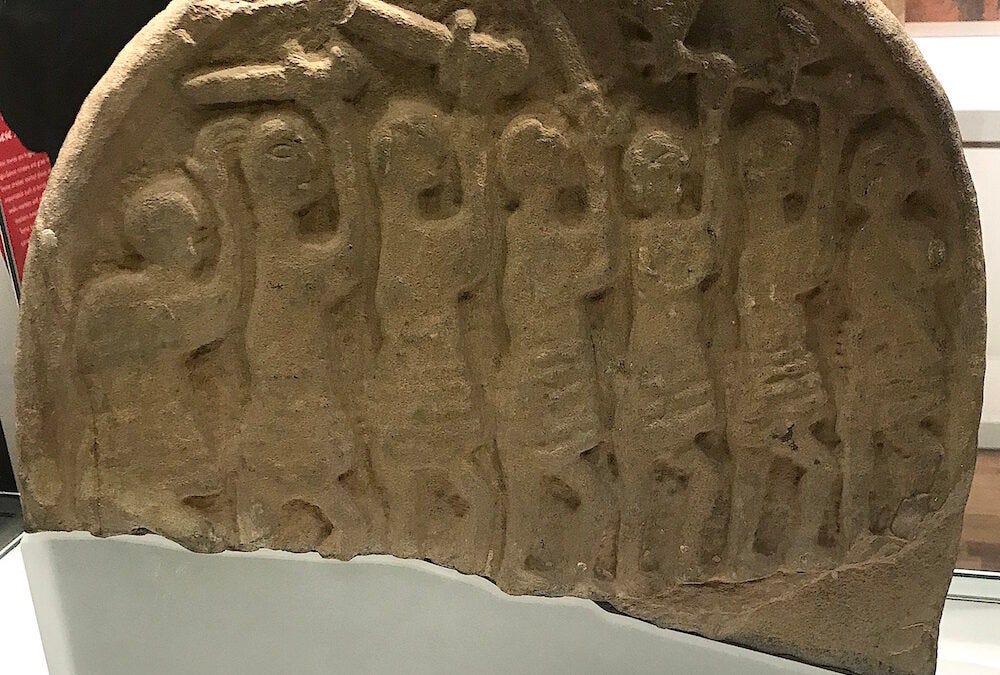The Viking Raid at Lindisfarne: Who Attacked the Monastery?
The Anglo-Saxon Chronicle records ‘terrible portents’ to the raid at Lindisfarne in 793 A.D. Located on Holy Island in the far north of England, it is written that the monastery saw powerful storms on the eve of the Vikings’ arrival.
It was an event that shook the Christian world to its core. So traumatic was its destruction that historians have agreed it should mark the official beginning of the Viking Age, even though it was not the first violence the British Isles experienced at the hands of the Vikings. The Anglo-Saxon Chronicle records ‘terrible portents’ to the raid at Lindisfarne in 793 A.D. Located on Holy Island in the far north of England, it is written that the monastery saw powerful storms on the eve of the Vikings’ arrival.
Who Attacked Lindisfarne?
The Anglo-Saxon Chronicle notes:
“793. Here terrible portents came about over the land of Northumbria, and miserably frightened the people: these were period flashes of lightning, and fiery dragons were seen flying in the air. A great famine immediately followed these signs, and a little after that in the same year on 8 January the raiding of heathen men miserably devastated God’s church in Lindisfarne island by looting and slaughter.”
The speed at which the Vikings are said to have arrived caught the monks completely by surprise. Reconstructions in past years have estimated that on a clear day a ship might only be seen as far as 18 nautical miles, a little over an hour’s journey for a longship with the wind at its back. If the Anglo-Saxon Chronicle is to be believed, the Vikings neither arrived on a clear day nor did the monks appear to have had an hour to flee.
The monk Alcuin, a leading theologian of his day who was from York but resided at the court of Charlemagne, wrote a reply to his colleague Bishop Higbald of Lindisfarne to lament the event. The letter from Higbald to Alcuin, which we believe described the raid in detail, has not survived to today, so Alcuin's reply is all we have to know what exactly happened. In his letter he wrote:
“We and our fathers have now lived in this fair land for nearly three hundred and fifty years, and never before has such an atrocity been seen in Britain as we have now suffered at the hands of a pagan people. Such a voyage was not thought possible. The church of St. Cuthbert is spaered with the blood of the priests of God, stripped of all its furnishings, exposed to the plundering of pagans – a place more sacred than any in Britain.”
Alcuin’s description lends to the idea that the clergy at Lindisfarne did little to flee their attackers. It may have been that the Vikings arrived so suddenly that the monks had no time to prepare at all. That Higbald survived the attack, however, tells us the raid was not an outright massacre, and at least some of the monks escaped and survived.
Alcuin's letter, although useful in piecing together the events of the raid on Lindisfarne, offers nothing in regards to who it was who carried out the attack. Perhaps Higbald's letter contained more information that may have given us more clues, but we are not so lucky as to have his letter. The question remains: who were the men who raided the island? Where did they come from?
Were the Vikings at Lindisfarne from Denmark?
The Anglo-Saxon Chronicle lists an entry from the year 787 A.D., six years before Lindisfarne, describing ‘Danes’ who arrived at the port of Portland. It recounts a brief encounter in which the port authority was killed for attempting to levy a tax on "Danish men". The Anglo-Saxon Chronicle reads:
“A.D., 787. This year King Bertric took Edburga the daughter of Offa to wife. And in his days came first three ships of the Northmen from the land of robbers. The Reve then rode thereto and would drive them to the king’s town; for he knew not what they were, and there was he slain. These were the first ships of the Danish men that sought the land of the English nation.”
The entry tells us the Danes had begun to eye the British Isles as early as six years before the raid at Lindisfarne. Given their proximity, and their relationship with Christendom, it would make sense the Danes attacked the monastery in 793.
The political climate between the Danes and the Carolingians may have also played a part in inciting the first raid. In 792 A.D. Emperor Charlemagne moved to suppress a Saxon rebellion under the leadership of a man named Widukind. His action was decisive and bloody. During the battle on the banks of the Elbe River, the Franks captured thousands of Saxon prisoners. As a means to send a message to the rest of the region, Charlemagne ordered the prisoners to be baptized in the river. There, the priests recited their benedictions as the Frankish soldiers held their victims underwater until they drowned.
The event, known as the “The Massacre of Verdun” was entirely in line with Charlemagne’s tactics to subdue pagan tribes. Widukind, the leader of the Saxons, was brother in law to the king of the Danes, Sigfred. News of the massacre undoubtedly reached the Danish court, and word of Charlemagne’s acts of violence would have spread across Scandinavia. It was yet another brutal, violent display of power by the Carolingians, the latest in a long series spanning decades.
From what historians can tell from the sources, Danish raids along the coast of Frisia intensified almost immediately after the massacre, leading to an infamous attack on Dorestad in 810, to which Charlemagne supposedly bore witness, if we are to believe the account given by the chronicler Einhart in his biography Two Lives of Charlemagne. Lindisfarne may have been a target during this time precisely because of its importance in the Christian world. A source about the attack by the twelfth century English chronicler Simeon of Durham, who drew from lost Northumbrian annals, described the events at Lindisfarne with precise details:
“And they came to the church at Lindisfarne, laid everything to waste with grievous plundering, trampled the holy places with polluted steps, dug up the altars and seized all the treasure of the holy church. They killed some of the brothers, took some away with them in feers, many they drove out, naked and loaded with insults, some they drowned in the sea..."
Some historians have taken this last passage to mean that the Vikings purposefully took priests to the water to drown them to make the point that they were retaliating against the encroachment of Christendom on Denmark. Other historians have disputed this as mere coincidence. If true, it might mean that the men who attacked Lindisfarne were indeed from Denmark.
Were the Vikings at Lindisfarne from Norway?
The evidence that leads historians to consider Norwegians were the ones to raid Lindisfarne resides in Alcuin's letter to Higbald. In it, he writes that the raid was a product of, "a voyage not thought possible." Danes had already traveled to the British Isles, and so the implication from Alcuin is that the heathens who sacked the monastery had traveled from much farther away.
A late 10th-century chronicler named Aethelweard, who drew from lost contemporary documents, added an additional clue to the mystery. He suggested the men who arrived at the port of Portland in 787 introduced themselves as men from Halogaland, in Norway. His suggestion contradicts the Anglo-Saxon Chronicle, which described the visitors in Portland as Danish men, but we must remember both histories were written long after the fact. Which chronicle is right? It is difficult to say, but Aethelweard is widely considered unreliable as a source due to the strange and often incomprehensible structure of his Latin. Therefore, most historians lean toward believing the Anglo-Saxon Chronicle over Aethelweard's Chronicon.
An Enduring Mystery
Although there is some light evidence to suggest it was either Danes or Norwegians who raided Lindisfarne, it is impossible to know for sure who carried out the attack. It just as easily could have been a church conspiracy – an inside job – to incriminate the ‘heathens’ for a barbaric act to spur more considerable efforts to convert Scandinavia. One could say that Alcuin’s inconsistencies, such as his assertion that “such a voyage was not thought possible,” despite knowing that Northmen had already visited Portland, point to a cover-up and overt effort to demonize them. Perhaps Alcuin, who was residing in Charlemagne’s court at the time, was the architect of a political hit job, and Lindisfarne was actually sacked by Frankish raiders under his orders – all so he could convince Charlemagne of the need to invade Jutland and force their conversion as had been done in Saxony.
Of course, the ‘inside job’ narrative is ridiculous, but it’s useful insofar as it showcases the nature of the study of the Vikings. Many of the significant events that marked that time period - even well-documented and ubiquitously known events such as the raid at Lindisfarne - are based on extremely light evidence and sparse, often unreliable primary sources. Therefore, in answer to the question of who attacked Lindisfarne, all we can really say is it was probably Danes, maybe Norwegians, but ultimately we do not and cannot know for sure.
As always, check out my selected bibliography for further reading.




